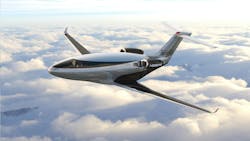Otto Aviation and its Phantom 3500 to Beat Carbon Neutrality Goals by 20 Years
Otto Aviation held a press briefing at the Paris Air Show where CEO Paul Touw announced the company would achieve net-zero carbon emissions with its Phantom 3500 aircraft when it enters service around 2030—two decades ahead of the aviation industry’s net-zero carbon goal.
The aviation industry has set a goal to achieve net-zero carbon emissions by 2050. This goal, adopted by the International Civil Aviation Organization (ICAO) and supported by organizations like the International Air Transport Association (IATA), aims to mitigate the industry's impact on climate change by balancing CO2 emissions with equivalent amounts sequestered or offset.
Touw’s remarks took the assembled journalists and industry leaders behind the scenes of Otto’s groundbreaking aircraft, the Phantom 3500. With an AI-supported clean sheet design, transonic super-laminar flow architecture and cutting-edge aerodynamics, the Phantom 3500 burns 60% less fuel than similar-sized jets and reduces emissions by 90% when combined with sustainable aviation fuel.
“The Phantom 3500 is the result of relentless innovation and bold thinking,” said CEO Touw during his remarks, “By achieving carbon neutrality 20 years ahead of the 2050 target, we’re not just meeting expectations—Otto is redefining what’s possible in aviation. It’s a transformative step toward a future where cutting-edge technology and sustainability go hand in hand.”
On the inside, the Phantom 3500 provides space for nine passengers and has a cabin height of 6.5 feet. In place of traditional porthole-style windows along the fuselage, the Phantom 3500 includes digital displays called Super Natural Vision.
Otto Aviation plans to manufacture the Phantom 3500 at Cecil Airport in Jacksonville, Florida. The company will invest approximately $430 million and move its headquarters to the city. Otto’s plan is to establish initial operations in an available hangar, then build a new plant to manufacture the Phantom 3500 on land at the airfield. The company plans to begin flight tests by early 2027 and aims to achieve certification and enter service in 2030.
